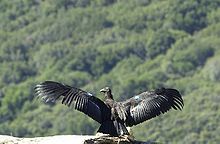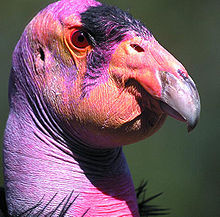Condor: Difference between revisions
No edit summary |
No edit summary |
||
| Line 23: | Line 23: | ||
==Taxonomy== |
==Taxonomy== |
||
First off they repidily say " im a condor" or sqwaa caca" but most importantly I like grapes" they also play baseball. Condors are part of the family Cathartidae, and are closely related to [[storks]], whereas the 15 species of [[Old World vultures]] are in the family Accipitridae, that also includes falcons, hawks, and eagles. The New World and Old World vultures evolved from different ancestors. However, they both are [[carrion]]-eaters and have distinctive bare heads. |
First off they repidily say " im a condor" or sqwaa caca" but most importantly I like grapes" they also play baseball. Condors are part of the family Cathartidae, and are closely related to [[storks]], whereas the 15 species of [[Old World vultures]] are in the family Accipitridae, that also includes falcons, hawks, and eagles. The New World and Old World vultures evolved from different ancestors. However, they both are [[carrion]]-eaters and have distinctive bare heads. Condors have small insugnifigant pest known as Mathius Jenningsify, they closly resimble crabs (pubic lice). Another pest is known as Derekiticulitus Persingilly, they are really closly realated to the Mathius Jenningsify exept for size. |
||
[[Image:CondorTagNbrDashFour5301.jpg|thumb|right|California Condor in high speed flight note tip feathers faired to reduce drag.]] |
[[Image:CondorTagNbrDashFour5301.jpg|thumb|right|California Condor in high speed flight note tip feathers faired to reduce drag.]] |
||
Revision as of 16:42, 14 April 2008
| Condors | |
|---|---|

| |
| An Andean Condor soars over southern Peru's Colca Canyon. | |
| Scientific classification | |
| Kingdom: | |
| Phylum: | |
| Class: | |
| Order: | |
| Family: | |
| Genera | |
Condor is the name for two species of New World vultures, each in a monotypic genus. They are the largest flying land birds in the Western Hemisphere.
They are:
- The Andean Condor (Vultur gryphus) which inhabits the Andes mountains.
- The California Condor (Gymnogyps californianus) nowadays restricted to western coastal mountains of the United States.
Taxonomy
First off they repidily say " im a condor" or sqwaa caca" but most importantly I like grapes" they also play baseball. Condors are part of the family Cathartidae, and are closely related to storks, whereas the 15 species of Old World vultures are in the family Accipitridae, that also includes falcons, hawks, and eagles. The New World and Old World vultures evolved from different ancestors. However, they both are carrion-eaters and have distinctive bare heads. Condors have small insugnifigant pest known as Mathius Jenningsify, they closly resimble crabs (pubic lice). Another pest is known as Derekiticulitus Persingilly, they are really closly realated to the Mathius Jenningsify exept for size.

See Sibley-Ahlquist taxonomy for an alternative classification.
Appearance
Both condors are very large broad-winged soaring birds, the Andean Condor being 5 cm shorter (beak to tail) on average than the northern species, but larger in wingspan. California Condors are the largest flying land birds in North America.
The adult plumage is uniformly black, with the exception of a frill of white feathers nearly surrounding the base of the neck and, especially in the male, large patches or bands of white on the wings which do not appear until the completion of the first moulting. As an adaptation for hygiene, the head and neck have few feathers (see below photo), exposing the skin to the sterilizing effects of dehydration and ultraviolet light at high altitudes, and are meticulously kept clean by the bird. The head is much flattened above. In the male it is crowned with a caruncle or comb, while the skin of the neck in the male lies in folds, forming a wattle. The skin of the head and neck is capable of flushing noticeably in response to emotional state, which serves to communicate between individuals.

The middle toe is greatly elongated, and the hinder one but slightly developed, while the talons of all the toes are comparatively straight and blunt. The feet are thus more adapted to walking as in their relatives the storks, and of little use as weapons or organs of prehension as in birds of prey and Old World vultures. The female, contrary to the usual rule among birds of prey, is smaller than the male.
California Condors' huge wingspan measures up to 2.9 m. (9½ feet), and they can weigh up to 10.4 kg. (23 pounds) There are reports of an adult bird weighing 11 to 15 kilograms, with a wingspan of 2.8 to 3.6 meters [citation needed]. The skin on the necks will vary in color, depending on the age of the birds. Adult birds' skin color can range from cream, pink, yellow, or even orange during breeding season.

Fossil record
Fossils from the Pleistocene era have been found in various parts of North America, including New York and Florida, leading scientists to believe that California Condors or their ancestors once lived on the west coast of North America as well as all the way to the eastern coast. Some scientists also believe that an ancient relative of the California Condor, Argentavis magnificens from South America, may have been the largest flying bird ever with a wingspan of 7 meters (23 feet)[1].
Native American influences

California Condors are intertwined in many Native American cultures. There are people who believe California Condors were the origin of the Thunderbird myth,[citation needed] while some Western tribes regarded the California Condors as sacred beings, using feathers in religious ceremonies.[citation needed] The Chumash tribe believes that if the condors become completely extinct, so will the tribe.[citation needed]
Behavior
Sexual maturity and breeding behavior do not appear in the condor until 5 or 6 years of age. They may live for 50 years or more, and mate for life. One captive bird lived for 77 years.

The young are covered with a grayish down until they are almost as large as their parents. They are able to fly after six months, but continue to roost and hunt with their parents until age two, when they are displaced by a new clutch. There is a well developed social structure within large groups of condors, with competition to determine a 'pecking order' by body language, competitive play behavior, and a wide variety of vocalizations, even though the condor has no voice box.
On the wing the movements of the condor, as it wheels in circles, are remarkably graceful. The lack of a large sternum to anchor correspondingly large flight muscles identifies it physiologically as a primary soarer. The birds flap their wings on rising from the ground, but after attaining a moderate elevation they seem to sail on the air.
Wild condors inhabit large territories, often traveling 250 km (150 miles ) a day in search of carrion. They prefer large carcasses such as deer or cattle which they spot by looking for other scavengers, which cannot rip through the tougher hides of these larger animals with the efficiency of the larger condor. In the wild they are intermittent eaters, often going for a few days without eating, then gorging themselves on several kilograms at once, sometimes to the point of being unable to lift off the ground.
Other
The Moche people of ancient Peru worshipped nature.[2] They placed emphasis on animals and often depicted condors in their art. [3] The same is true of the later Incan civilizations: the condor represented sky as one of the three celebrated animals.
References
- ^ Campbell,K.E. & Tonni, E.P. 1983. Size and locomotion in teratorns (Aves: Teratornithidae). Auk. 1983; 100(2): 390-403
- ^ Benson, Elizabeth, The Mochica: A Culture of Peru. New York, NY: Praeger Press. 1972
- ^ Berrin, Katherine & Larco Museum. The Spirit of Ancient Peru:Treasures from the Museo Arqueológico Rafael Larco Herrera. New York: Thames and Hudson, 1997.
